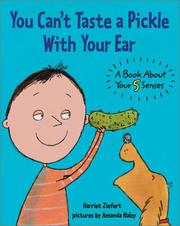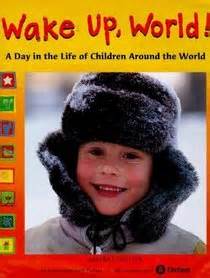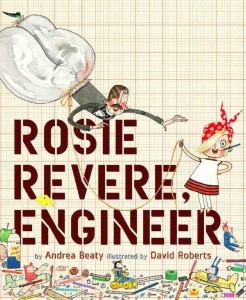You Can’t Taste a Pickle With Your Ear
 When it comes to Common Core State Standards, the one that I think is the most fun is Range of Reading. (I know, I know, all the CCSS are fun, but this one is the most fun!) Range of Reading: Informational Text means we want kids to “read and comprehend informational texts, including history/social studies, science, and technical texts.” In other words, we can share all kinds of cool nonfiction books with our students, and I have a fun pick this week.
When it comes to Common Core State Standards, the one that I think is the most fun is Range of Reading. (I know, I know, all the CCSS are fun, but this one is the most fun!) Range of Reading: Informational Text means we want kids to “read and comprehend informational texts, including history/social studies, science, and technical texts.” In other words, we can share all kinds of cool nonfiction books with our students, and I have a fun pick this week.
You Can’t Taste a Pickle With Your Ear: A Book About Your 5 Senses by Harriet Ziefert with pictures by Amanda Haley is an informational picture book with a great sense of humor. It has some nice text features like a table of contents, an introduction, a conclusion, and questions at the end of each mini-chapter for discussion. The information presented about the five senses is appropriate for early elementary students and will work well for any “all about me” units as well as for health and science studies.
Read aloud the title You Can’t Taste a Pickle With Your Ear and you’ll get students grinning. You can read the 32-page book in one sitting, or read each mini-chapter devoted to a different sense one at a time. For an art activity that will bring together all the information in the book (so we’re Integrating Knowledge & Ideas as well as working on Range of Reading), have students make a self-portrait and label the body parts they use for each of the five senses. To get those Nature Smart/experiential learners really involved, bring in pickles for the class. Students can write about how they used each of their five senses as they look at, smell, touch, hear (long crunchy pickles that snap in half work best), and taste. Remind your students again about the title of the book (but keep paper towels on hand in case any of your students feel the need to test for themselves.)
Read MoreWake Up, World!
 “We all should know that diversity makes for a rich tapestry, and we must understand that all the threads of the tapestry are equal in value no matter what their color.” – Maya Angelou
“We all should know that diversity makes for a rich tapestry, and we must understand that all the threads of the tapestry are equal in value no matter what their color.” – Maya Angelou
Books that celebrate diversity are perfect at the beginning of a new school year. We want our students to know that all of us are valued because of, not in spite of, the unique characteristics we possess. Wake Up, World! A Day in the Life of Children Around the World by Beatrice Hollyer in association with Oxfam shows students in an accessible way what life is like in different parts of the world.
Meet eight children from places like Vietnam, Ghana, Brazil, and the United States. From waking up and eating breakfast, to going to school and doing chores, to going to bed (or hammock), readers will love the photos and descriptions of what life is like for kids just like them in other countries. (You will love how easy it is to work in Range of Reading and Integrating Knowledge & Ideas with one book, and even tie it into a mapping unit if you are so inclined.)
One of the children, Natali, is from California in the United States. With the paragraphs about Natali especially, your students may find themselves saying “that’s just like me!” or “I don’t do that!” You can play a game called “Cross the Line” with information you find in this book. Line all of your students on one side of your classroom, and either imagine a line down the middle of the room, or put one there with masking tape (and thank your custodial staff for being so nice to teachers who put down tape on the floor.) Choose situations from the book like “if you drink walk to school like Linh from Vietnam does, cross the line.” Students can easily see who shares that characteristic with them. Wake Up, World! is also an ideal writing prompt. Your students can write about what they eat for breakfast, etc. for a book like “Our Classroom Wakes Up”or for individual books.
For more information about Oxfam, please visit oxfam.org.
Read MorePeace
 It has been twelve years since the terror attacks on 9/11. Most of the students in elementary classrooms today weren’t even born yet in 2001, so how do we commemorate that day with kids? The kindest way I can think of to honor the lives that were lost is to promote peace, and the most beautiful book I know about peace is this one.
It has been twelve years since the terror attacks on 9/11. Most of the students in elementary classrooms today weren’t even born yet in 2001, so how do we commemorate that day with kids? The kindest way I can think of to honor the lives that were lost is to promote peace, and the most beautiful book I know about peace is this one.
Peace by Wendy Anderson Halperin combines art, poetry, and quotes to help answer the question “how do we make a peaceful world?” The book is quiet and thoughtful, with detailed pictures your students will want to spend time examining close up. You can read aloud the main thread of the poem, which begins with
“For there to be peace in the world…/ …there must be peace in nations./ For there to be peace in nations, there must be peace in cities.”
and then take time to read all the beautiful quotes threaded throughout.
“It’s not so much the journey that’s important, as the way we treat those we encounter and those around us, along the way.” – Jeremy Aldana
Wendy Anderson Halperin has a beautiful website that extends the book: drawingchildrenintopeace.com. She has cool videos where she teaches kids how to draw different peace symbols and she talks about conflict resolution. You can even browse through a gallery of art where kids have drawn and written what peace means to them.
I hope you share Peace with your students. I hope you take time to discuss some of the beautiful quotes, not just because it works for Range of Reading and Craft & Structure, but because they may plant hopeful seeds in your students. If your students choose a quote to illustrate, or write a peace quote of their own and add pictures, you can send it to Wendy Halperin, and send it to me, too. I am all about sharing peace.
For more information about the author/illustrator, please visit wendyhalperin.com.
Read MoreRosie Revere, Engineer
I have the best of reasons for posting late this week: I’ve been on Mackinac Island at the Michigan Reading Association conference, being inspired by dedicated educators and loving the slower pace of an island with no automobiles. Now I’m sitting in a white wicker rocking chair with a cup of coffee and my laptop, dear husband at my side, watching sailboats glide by. The only thing that could make this any better would be a great book, and luckily, I have one.
Rosie Revere, Engineer written by the marvelously talented Andrea Beaty and illustrated by David Roberts is one of the rare rhyming book gems: the story is as solid as the meter and the language isn’t dumbed down in order to make a rhyme. Rosie Revere is the kind of girl most creative people will relate to: joyfully inventive, but so fearful of failure and ridicule that she hides her inventions away. The “gadgets and gizmos” she creates are fantastic, and I love Roberts’ whimsical and yet credible drawings of them. (I myself would love a pair of Rosie’s helium pants.) Rosie’s desire to help her great-great-aunt Rose fulfill her lifelong dream of flying gives Rosie the courage to test one of her inventions.
“The heli-o-cheese-copter sputtered and twitched.
It floated a moment and whirled round and round,
then froze for a heartbeat and crashed to the ground.”
Rosie is devastated by the failure, and by her great-great-aunt’s laughter, until she hears,
“‘Your brilliant first flop was a raging success!
Come on, let’s get busy and on to the next!’“
So not only is the message of this book one that every creative person with perfectionist tendencies needs to hear (I’m keeping it by my bedside table as a reminder) but it has historical notes in it about Amelia Earhart and E. Lillian Todd (the first woman to design airplanes) and Rosie the Riveter and other strong women whose names and deeds should be known. For a social studies lesson, you could easily springboard from this book into studying awesome women inventors. For math-science-art, get graph paper and a bunch of doodads and thing-a-ma-bobs for students to plan, design, build, test, and refine their own inventions. If you ask people to donate old, broken electronic gadgets to your class and bring in small tools, your students can take apart old radios and remote controls to disassemble and use. Build those Phonological Awareness skills by focusing on the rhyme, then discuss the interesting word choices for a Craft & Structure lesson. To keep rocking those Core Standards in Reading, you can easily work in Integrating Knowledge & Ideas by comparing Rosie Revere, Engineer to Iggy Peck, Architect by the same power duo.
So share this book with absolutely everyone you know, and get busy taking creative risks, because
“Life might have its failures, but this was not it.
The only true failure can come if you quit.”
For more information on the author, please visit andreabeaty.com.
For more information on the illustrator, please visit davidrobertsillustration.com.








